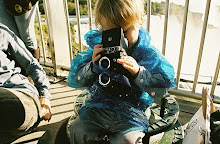
Dear Jonas:
Today you, your Dad, and I went to the coffee shop around the corner for bagels and coffee. You’re starting to sit straight up in your sling, so you got to meet two of our neighbors and three dogs before we’d even left the apartment building. On our way into the coffee shop an old lady wandering down the street caught sight of you: “A boy!” she confirmed. Yes, I replied, wary of her approval. “Good!” she blared, and improbably started calling you “Butchy Butchy Butchy.” Your onesie was stitched with rainbow-colored giraffes outlined in pink and turquoise—the picture of infant machismo. (I’d thought your femme onesies would perform a sort of armor against the ever-present gender fairy godmothers, but I was dead wrong.) Suddenly, her face hardened: “Stupid pacifiers. I don’t believe in ‘em,” she chided us, and abruptly skulked away. We raised our eyebrows at each other and went into the coffee shop.
Daddy and I ordered, sat down, and began reading the paper. You fell asleep. I started, as usual, with the Sunday Styles' weekly homage to nihilism: the modern love column. Then I flipped through the rest of the section. I like seeing which topics are siphoned off as matters of style each week—their alleged silliness made anodyne through their separation from serious news. That wedding announcements and contemporary confessions of desire are interpreted as style seems as telling as the relocation of Frank Rich from Arts & Leisure to Op-Ed, but that was before your time. Today Sunday Styles ran an article, inspired by Mayor Bloomberg’s intention to run for a third term, on what one numerologist describes as the “sunshine” number: three. The article has gone silly over triplicates: “Whence, then, the lure of three? How did it become the perfect number of fairy tale characters, of stooges, of syllables in a loved one’s name — tip of the tongue taking a trip of three steps down the palate to tap, at three, on the teeth?”
Me: “Huh. There’s this goofy article on the significance of the number three. It doesn’t mention the dialectic. Not even once.”
Daddy: “I’m sorry, did you not notice that you’re reading the STYLE section?”
Me: "I know. I know. But the dialectic is precisely about style; it uses form as argument."
Here’s Uncle Jameson on Adorno in Marxism and Form: “But dialectical thinking is thought to the second power, a thought about thinking itself, in which the mind must deal with its own thought process just as much as with the material it works on, in which both the particular content involved and the style of thinking suited to it must be held together in the mind at the same time.”
And Uncle Hebdige from Subculture and the Meaning of Style: “However, the challenge to hegemony which subcultures represent is not issued directly by them. Rather it is expressed obliquely, in style.”
Now, I understand that the New York Times is the antithesis of a subcultural publication, but its omissions frame and inform readers through a kind of dialectical process. Sunday Styles positions style as consumption, rendering it harmless and accessible. This argument is oblique only through its obviousness, leaving readers to think to the second power, to hold out for the possibility of what an analysis of style might bring. In other words, Butchy, after you learn how to make sense of what’s on the page, you’ll have to flip that skill and keep abreast of what you’re not seeing, too.
